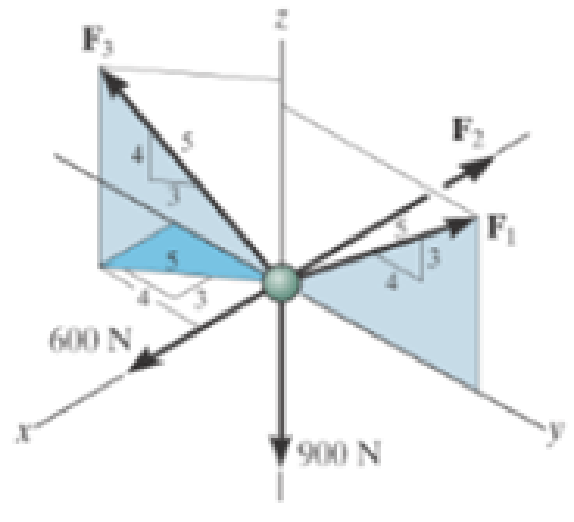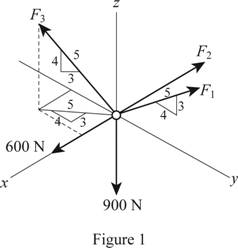
Determine the magnitude of forces F1, F2, F3, so that the particle is held in equilibrium.

Answer to Problem 7FP
The magnitude of force
The magnitude of force
The magnitude of force
Explanation of Solution
Given information:
The given force values are 600 N and 900 N.
Explanation:
Show the free body diagram of the forces acting on the particle as in Figure 1.

Using Figure (1),
Determine the magnitude of forces using equation of equilibrium.
Force along x direction:
Force along y direction:
Force along z direction:
Conclusion:
Substitute
Thus, the magnitude of force
Substitute
Thus, the magnitude of force
Substitute
Thus, the magnitude of force
Want to see more full solutions like this?
Chapter 3 Solutions
Engineering Mechanics: Statics
Additional Engineering Textbook Solutions
Thinking Like an Engineer: An Active Learning Approach (3rd Edition)
Automotive Technology: Principles, Diagnosis, and Service (5th Edition)
Automotive Technology: Principles, Diagnosis, And Service (6th Edition) (halderman Automotive Series)
Mechanics of Materials
Applied Fluid Mechanics (7th Edition)
Statics and Mechanics of Materials (5th Edition)
- The rope that makes up the system has a total length of 5 m.At D there is a load of weight W = 1320 N.Calculate the value of the load to be placed at B so that the system remains in equilibrium when S = 1,5 m.arrow_forwardUse the equilibrium equations.arrow_forwardDetermine the magnitude of the force P required to hold the 300-kg crate in equilibriumarrow_forward
- 1. Determine the magnitudes of F, F, and F, for equilibrium of the particle. F3 30°, F2 F1 4 y 60° 30° 800 Narrow_forwardDetermine the magnitude of the components of the force and the lever arm d that would put the structure below in equilibrium. F1 = 20 N, F2 = 10 N F3 = 5 N, a = 2.0 m, b = 3.0 m, c = 1.0 m. Fh =Fv = d =arrow_forwardF,- 520 N 12 F2 F = 600 N Detemine the magnitudes of F1 and F2 so that the particle P is in equilibriumarrow_forward
- If the mass of the flowerpot is 65 kg, calculate the tension generated in every cable for equilibrium. Assume r = 1.5 m and z = 2 m. C+2m 3 m - 6 marrow_forwardQ3: The 500-1b cylinder is supported by three chains as shown. Determine the force in each chain for equilibrium. Z 135⁰ 90° 1 ft 41359 B 18 ft 500 lb yarrow_forwardTwo forces F1 150 N and F2 50 N to hold the weight of 200 N. Check and determine if the body is in equilibrium or otherwise. If it's not in equilibrium then in which direction how much force F3 shall be applied to make the frame in equilibrium. While F3 cannot make angle greater than 45° with x-axis. F3 y B 40° 200 Narrow_forward
- If block B weighs 300 lb and block C weighs 200 lb, determine the following: 3.1 The required angle for equilibrium is Blank 1°. 3.2 The required weight of block D for equilibrium is Blank 2 lb. 3.3 If block D weighs 253 lb and the measure of angle = 39.2°, determine the required weight of block B for equilibrium.arrow_forwardI need the answer as soon as possiblearrow_forwardbläs 4 The body is in equilibrium when the resultant of the force acting .on dose not zero true O False Oarrow_forward
 International Edition---engineering Mechanics: St...Mechanical EngineeringISBN:9781305501607Author:Andrew Pytel And Jaan KiusalaasPublisher:CENGAGE L
International Edition---engineering Mechanics: St...Mechanical EngineeringISBN:9781305501607Author:Andrew Pytel And Jaan KiusalaasPublisher:CENGAGE L
